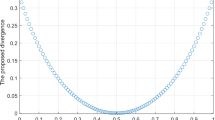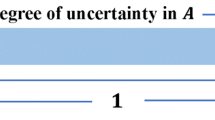Abstract
Dempster-Shafer evidence theory (DSET) has a wide and important application in information fusion. However, when the pieces of evidence are highly conflicting, Dempster’s rule may lead to counter-intuitive results. To address this issue, a new enhanced belief Jensen-Sharma-Mittal (\(\mathcal {EBJSM}\)) divergence is proposed in this paper to measure the degree of conflict between the pieces of evidence. The \(\mathcal {EBJSM}\) divergence takes into account the influence of both single-element and multiple-element subsets. Furthermore, important properties of the \(\mathcal {EBJSM}\) divergence are explored and proved, including its non-negativity, non-degeneracy, symmetry and relationships with the belief Jensen-Tsallis divergence, the belief Jensen-Rényi divergence, the Kullback–Leibler divergence, the Hellinger distance and \(\chi ^2\) divergence. Based on the \(\mathcal {EBJSM}\) divergence and the improved belief entropy, a new multi-sensor information fusion method is designed. Finally, the proposed multi-sensor information fusion method is applied to several applications, and the practicality and effectiveness of the new method is verified. In particular, the proposed method achieved the best average classification accuracy of 0.9292 on the Iris dataset.








Similar content being viewed by others
Data availability
All data information is included in the paper.
References
Aggarwal M (2017) Rough information set and its applications in decision making. IEEE Trans Fuzzy Syst 25(2):265–276
Crooks GE (2017) On measures of entropy and information. Tech Note 9:4
Dempster A (1967) Upper and lower probabilities induced by a multivalued mapping. Ann. Math. Stat., 325–339
Deng Y, Shi W, Zhu Z, Liu Q (2004) Combining belief functions based on distance of evidence. Decis Support Syst 38(3):489–493
Dubois D, Prade H (1988) Representation and combination of uncertainty with belief functions and possibility measures. Comput Intell 4(3):244–264
Dubois D, Prade H (2001) Possibility theory, probability theory and multiple-valued logics: A clarification. Ann Math Artif Intell 32:35–66
Gao X, Xiao F (2022) An improved belief \(\chi ^2\) divergence for dempster-shafer theory and its applications in pattern recognition. Comput Appl Math 41(6):277
Garg H, Kumar K (2019) Linguistic interval-valued atanassov intuitionistic fuzzy sets and their applications to group decision-making problems. IEEE Trans. Fuzzy Syst., 1–1
Ghosh R, Kumar P, Roy PP (2019) A dempster-shafer theory based classifier combination for online signature recognition and verification systems. Int J Mach Learn Cybern 10:2467–2482
He Y, Deng Y (2022) Mmget: a markov model for generalized evidence theory. Comput Appl Math 41:1–41
He Y, Xiao F (2022) A new base function in basic probability assignment for conflict management. Appl Intell 52(4):4473–4487
Huang C, Mi X, Kang B (2021) Basic probability assignment to probability distribution function based on the shapley value approach. Int J Intell Syst 36(8):4210–4236
Huang H, Liu Z, Han X, Yang X, Liu L (2023) A belief logarithmic similarity measure based on dempster-shafer theory and its application in multi-source data fusion. J Intell Fuzzy Syst 45(3):4935–4947
Islam SM, Wu T, Ledwich G (2000) A novel fuzzy logic approach to transformer fault diagnosis. IEEE Trans Dielectr Electr Insul 7(2):177–186
Jiang W (2018) A correlation coefficient for belief functions. Int J Approx Reason 103:94–106
Kaur M, Srivastava A (2022) A new divergence measure for belief functions and its applications. Int. J. General Syst., 1–18
Lee H, Kwon H (2021) DBF: Dynamic belief fusion for combining multiple object detectors. IEEE Trans Pattern Anal Mach Intell 43(5):1499–1514
Li Y, Pelusi D, Deng Y (2020) Generate two-dimensional belief function based on an improved similarity measure of trapezoidal fuzzy numbers. Comput Appl Math 39:1–20
Li X, Liu Z, Han X, Liu N, Yuan W (2023) An intuitionistic fuzzy version of hellinger distance measure and its application to decision-making process. Symmetry 15(2):500
Lin Y, Li Y, Yin X, Dou Z (2018) Multisensor fault diagnosis modeling based on the evidence theory. IEEE Trans Reliab 67(2):513–521
Liu Z (2023) Credal-based fuzzy number data clustering. Granul Comput 8:1907–1924
Liu Z (2023) An effective conflict management method based on belief similarity measure and entropy for multi-sensor data fusion. Artif Intell Rev 56:15495–15522
Liu Z (2023) An evidential sine similarity measure for multisensor data fusion with its applications. Comput Granul. https://doi.org/10.1007/s41066-023-00426-6
Liu Z, Huang H (2023) Comment on “new cosine similarity and distance measures for fermatean fuzzy sets and topsis approach’’. Knowl Inf Syst 65:5151–5157
Liu P, Xiao F (2022) Earth mover’s divergence of belief function. Comput Appl Math 41(6):292
Liu Z, Cao Y, Yang X, Liu L (2023) A new uncertainty measure via belief rényi entropy in dempster-shafer theory and its application to decision making. Commun. Stat. - Theory Methods, 1–20. https://doi.org/10.1080/03610926.2023.2253342
Liu Z, Huang H, Letchmunan S (2023) Adaptive weighted multi-view evidential clustering. In: Int. Conf. Artif. Neural Networks, pp. 265–277
Lu P, Zhou Y, Wu Y, Li D (2022) Risk assessment of complex footbridge based on dempster-shafer evidence theory using fuzzy matter-element method. Appl Soft Comput 131:109782
Ma Z, Liu Z, Luo C, Song L (2021) Evidential classification of incomplete instance based on k-nearest centroid neighbor. J Intell Fuzzy Syst 41(6):7101–7115
Murphy CK (2000) Combining belief functions when evidence conflicts. Decis Support Syst 29(1):1–9
Pan Y, Zhang L, Li Z, Ding L (2020) Improved fuzzy bayesian network-based risk analysis with interval-valued fuzzy sets and d-s evidence theory. IEEE Trans Fuzzy Syst 28(9):2063–2077
Shafer G (1976) A Mathematical Theory of Evidence, vol 42. Princeton University Press, Princeton
Sharma BD, Mittal DP (1975) New non-additive measures of entropy for discrete probability distributions. J Math Sci 10:28–40
Smets P (1990) The combination of evidence in the transferable belief model. IEEE Trans Pattern Anal Mach Intell 12(5):447–458
Wang H, Deng X, Jiang W, Geng J (2021) A new belief divergence measure for Dempster-Shafer theory based on belief and plausibility function and its application in multi-source data fusion. Eng Appl Artif Intell 97:104030
Xiao F (2019) Multi-sensor data fusion based on the belief divergence measure of evidences and the belief entropy. Inf Fusion 46:23–32
Xiao F (2020) Generalized belief function in complex evidence theory. J Intell Fuzzy Syst 38(4):3665–3673
Xiao F (2022) Ceqd: A complex mass function to predict interference effects. IEEE Trans Cybern 52(8):7402–7414
Xiao F (2022) GEJS: A generalized evidential divergence measure for multisource information fusion. IEEE Trans Syst Man Cybern Syst. https://doi.org/10.1109/TSMC.2022.3211498
Xiao F, Pedrycz W (2023) Negation of the quantum mass function for multisource quantum information fusion with its application to pattern classification. IEEE Trans Pattern Anal Mach Intell 45(2):2054–2070
Xiao F, Cao Z, Jolfaei A (2021) A novel conflict measurement in decision-making and its application in fault diagnosis. IEEE Trans Fuzzy Syst 29(1):186–197
Xiao F, Wen J, Pedrycz W (2023) Generalized divergence-based decision making method with an application to pattern classification. IEEE Trans Knowl Data Eng 35(7):6941–6956
Xiao F, Cao Z, Lin C-T (2023) A complex weighted discounting multisource information fusion with its application in pattern classification. EEE Trans Knowl Data Eng 35(8):7609–7623
Yager RR (1987) On the dempster-shafer framework and new combination rules. Inf Sci 41(2):93–137
Zhao K, Sun R, Li L, Hou M, Yuan G, Sun R (2021) An improved evidence fusion algorithm in multi-sensor systems. Appl. Intell., 1–11
Zhu S, Liu Z (2023) Distance measures of picture fuzzy sets and interval-valued picture fuzzy sets with their applications. AIMS Math 8(12):29817–29848
Zhu C, Xiao F (2023) A belief Rényi divergence for multi-source information fusion and its application in pattern recognition. Appl Intell 53(8):8941–8958
Funding
None.
Author information
Authors and Affiliations
Corresponding author
Ethics declarations
Conflict of interest
The author declare that they have no conflict interest.
Ethics approval
This article does not contain any studies with human participants or animals performed by any of the authors.
Additional information
Communicated by Graçaliz Pereira Dimuro.
Publisher's Note
Springer Nature remains neutral with regard to jurisdictional claims in published maps and institutional affiliations.
Rights and permissions
Springer Nature or its licensor (e.g. a society or other partner) holds exclusive rights to this article under a publishing agreement with the author(s) or other rightsholder(s); author self-archiving of the accepted manuscript version of this article is solely governed by the terms of such publishing agreement and applicable law.
About this article
Cite this article
Lyu, S., Liu, Z. A belief Sharma-Mittal divergence with its application in multi-sensor information fusion. Comp. Appl. Math. 43, 34 (2024). https://doi.org/10.1007/s40314-023-02542-0
Received:
Revised:
Accepted:
Published:
DOI: https://doi.org/10.1007/s40314-023-02542-0
Keywords
- Multi-sensor information fusion
- Dempster-Shafer evidence theory
- Jensen-Sharma-Mittal divergence
- Belief entropy




